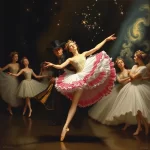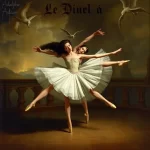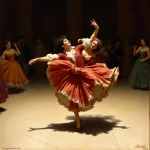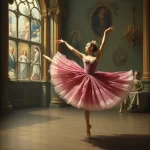Ballet: The Magic Flute (Riccardo Drigo, 1893)

Introduction
Ballet, an art form that combines music, dance, and storytelling, has produced numerous masterpieces over the centuries. One such gem is “The Magic Flute,” a ballet composed by Riccardo Drigo in 1893. This ballet, choreographed by Lev Ivanov, premiered on November 10, 1893, at the Imperial Mariinsky Theatre in St. Petersburg, Russia. The ballet is a whimsical tale that intertwines elements of magic, romance, and adventure, captivating audiences with its enchanting narrative and exquisite choreography.
Historical Background
Creation and Development
The late 19th century was a period of significant transformation in the world of ballet. The Imperial Russian Ballet was at the forefront of this evolution, with choreographers and composers pushing the boundaries of the art form. “The Magic Flute” was created during this vibrant era, influenced by the rich cultural and artistic milieu of the time. The ballet drew inspiration from various sources, including folklore and literary works, which were prevalent themes in the arts during this period.
The collaboration between choreographer Lev Ivanov and composer Riccardo Drigo was instrumental in bringing “The Magic Flute” to life. Ivanov, known for his lyrical and expressive choreography, worked closely with Drigo, whose music perfectly complemented the ballet’s fantastical elements. Their partnership resulted in a seamless blend of dance and music, creating a magical experience for the audience.
Premiere and Reception
“The Magic Flute” premiered on November 10, 1893, at the Imperial Mariinsky Theatre in St. Petersburg. The initial reception was overwhelmingly positive, with critics and audiences praising the ballet’s enchanting storyline, captivating choreography, and Drigo’s delightful score. The ballet quickly became a favorite among the repertoire of the Imperial Russian Ballet, leading to numerous revivals and performances in the years that followed.
Synopsis of the Ballet
Act I Summary
The ballet opens with the introduction of the main characters: Prince Tamino, Princess Pamina, and the evil sorcerer Sarastro. Prince Tamino is on a quest to rescue Princess Pamina, who has been captured by Sarastro. Along the way, Tamino encounters various magical creatures and obstacles, but he is aided by a magical flute that has the power to overcome any challenge.
Act II Summary
In the second act, Tamino and Pamina face a series of trials set by Sarastro to test their love and bravery. With the help of the magical flute, they successfully navigate these challenges, demonstrating their unwavering commitment to each other. The act culminates in a dramatic confrontation between Tamino and Sarastro, where the power of love and music ultimately triumphs over evil.
Finale
The ballet concludes with a joyous celebration of Tamino and Pamina’s victory. The magical flute, which played a crucial role in their journey, is honored as a symbol of their love and courage. The final scene is a grand spectacle of dance and music, leaving the audience with a sense of wonder and enchantment.
Musical Composition
Composer’s Role
Riccardo Drigo, an Italian composer and conductor, played a pivotal role in the creation of “The Magic Flute.” Drigo’s music is characterized by its melodic richness and emotional depth, which perfectly complement the ballet’s narrative. His score for “The Magic Flute” includes several notable pieces, such as the enchanting overture and the mesmerizing pas de deux, which have become iconic in the world of ballet.
Musical Themes and Motifs
Drigo’s score for “The Magic Flute” is imbued with recurring musical themes and leitmotifs that enhance the narrative and emotional impact of the ballet. The magical flute itself is represented by a distinctive musical motif that recurs throughout the ballet, symbolizing its power and significance. The music also reflects the characters’ emotions and the various magical elements of the story, creating a rich and immersive experience for the audience.
Famous Recordings and Performances
Over the years, “The Magic Flute” has been performed by numerous prestigious ballet companies around the world. Several recordings of Drigo’s score have been made, capturing the beauty and magic of the music. Notable performances include those by the Mariinsky Ballet and the Bolshoi Ballet, which have brought the ballet to life with their exceptional artistry and interpretation.
Choreography and Dance
Choreographer’s Vision
Lev Ivanov’s choreography for “The Magic Flute” is a testament to his visionary approach to ballet. Ivanov’s style is characterized by its lyrical and expressive quality, which perfectly complements the whimsical and fantastical elements of the story. His choreography for “The Magic Flute” includes several innovative elements, such as the use of mime and character dance, which add depth and richness to the narrative.
Signature Dance Numbers
“The Magic Flute” features several signature dance numbers that have become iconic in the world of ballet. The pas de deux between Tamino and Pamina is a highlight of the ballet, showcasing their love and commitment through exquisite choreography. Other notable dance numbers include the solo performances by the magical creatures and the dramatic confrontation between Tamino and Sarastro, which are both visually and emotionally captivating.
Notable Interpretations
Over the years, “The Magic Flute” has been interpreted and adapted by various ballet companies and choreographers. Each production brings its unique vision and style to the ballet, adding new layers of meaning and interpretation. Notable interpretations include those by the Royal Ballet and the American Ballet Theatre, which have brought fresh perspectives and innovative choreography to the classic tale.
Characters and Roles
Main Characters
- Prince Tamino: The hero of the story, Tamino is a brave and noble prince on a quest to rescue Princess Pamina. His character is characterized by his courage, determination, and unwavering love for Pamina.
- Princess Pamina: The heroine of the story, Pamina is a kind and gentle princess who has been captured by the evil sorcerer Sarastro. Her character is characterized by her grace, beauty, and inner strength.
- Sarastro: The antagonist of the story, Sarastro is an evil sorcerer who has captured Pamina. His character is characterized by his cunning, cruelty, and desire for power.
Supporting Characters
- The Queen of the Night: Pamina’s mother, who initially appears to be an ally but later reveals her true intentions.
- Papageno: A comical bird-catcher who provides comic relief and assists Tamino on his quest.
- The Three Spirits: Magical beings who guide and assist Tamino and Pamina on their journey.
Famous Dancers
Several notable dancers have portrayed the lead roles in “The Magic Flute” over the years. Renowned dancers such as Rudolf Nureyev, Mikhail Baryshnikov, and Natalia Makarova have brought their exceptional artistry and interpretation to the roles of Tamino and Pamina, leaving a lasting impact on the ballet’s legacy.
Cultural and Artistic Impact
Influence on Ballet and Dance
“The Magic Flute” has had a significant influence on the world of ballet and dance. Its innovative choreography, enchanting music, and captivating narrative have inspired countless choreographers and composers. The ballet’s success also contributed to the development of ballet as an art form, pushing the boundaries of what was possible in terms of storytelling and artistic expression.
Cultural Significance
The ballet’s cultural significance extends beyond the world of dance. “The Magic Flute” has been referenced and adapted in various forms of popular culture, literature, and other media. Its themes of love, bravery, and the triumph of good over evil resonate with audiences of all ages, making it a timeless and enduring work of art.
Legacy and Revivals
“The Magic Flute” continues to be performed and celebrated today, with numerous revivals and reinterpretations by ballet companies around the world. Modern adaptations have brought fresh perspectives and innovative choreography to the classic tale, ensuring its continued relevance and appeal. The ballet’s legacy is a testament to its enduring magic and the timeless power of its story and music.
Iconic Productions
Historic Productions
Several historic productions of “The Magic Flute” have left a lasting impact on the ballet’s legacy. The original production by the Imperial Russian Ballet, with its lavish sets and costumes, set the standard for future performances. Other notable historic productions include those by the Paris Opera Ballet and the Royal Danish Ballet, which brought their unique interpretations and styles to the ballet.
Contemporary Productions
Contemporary productions of “The Magic Flute” continue to captivate audiences with their innovative choreography and modern interpretations. Recent productions by the Royal Ballet and the American Ballet Theatre have brought fresh perspectives to the classic tale, incorporating new elements and styles while staying true to the original spirit of the ballet.
Production Design
The production design of “The Magic Flute” plays a crucial role in bringing the magical world of the ballet to life. Lavish sets, intricate costumes, and imaginative lighting design create a visually stunning experience for the audience. Each production brings its unique vision to the ballet, adding new layers of meaning and interpretation through its design elements.
Critical Reception and Reviews
Initial Critical Response
The initial critical response to “The Magic Flute” was overwhelmingly positive. Critics praised the ballet’s enchanting storyline, captivating choreography, and Drigo’s delightful score. The ballet quickly became a favorite among audiences, leading to numerous revivals and performances in the years that followed.
Modern Reviews
Contemporary critics and audiences continue to appreciate “The Magic Flute” for its timeless appeal and artistic excellence. Modern reviews highlight the ballet’s innovative choreography, enchanting music, and captivating narrative. The ballet’s enduring popularity is a testament to its lasting impact and significance in the world of dance.
Fun Facts and Trivia
Behind-the-Scenes Stories
One interesting behind-the-scenes story from the original production of “The Magic Flute” involves a mishap with the magical flute prop. During one performance, the flute accidentally broke on stage, leading to an impromptu and humorous moment as the dancers improvised with the broken prop.
Notable Performers
Several famous dancers, conductors, and directors have been associated with “The Magic Flute” over the years. Renowned dancers such as Rudolf Nureyev, Mikhail Baryshnikov, and Natalia Makarova have brought their exceptional artistry to the lead roles, while conductors like Valery Gergiev have brought Drigo’s score to life with their masterful interpretations.
Trivia
- “The Magic Flute” was one of the first ballets to incorporate elements of mime and character dance, adding depth and richness to the narrative.
- The ballet’s magical flute prop is often intricately designed and crafted, adding to the visual enchantment of the production.
- Riccardo Drigo composed several other notable ballets, including “Le Talisman” and “Harlequinade,” which are also celebrated for their enchanting music and captivating narratives.
Conclusion
Summary of the Ballet’s Importance
“The Magic Flute” is a significant work in the world of ballet, known for its enchanting storyline, captivating choreography, and delightful music. The collaboration between Lev Ivanov and Riccardo Drigo resulted in a seamless blend of dance and music, creating a magical experience for audiences. The ballet’s enduring popularity and influence on the art form are a testament to its lasting impact and significance.
Final Thoughts
“The Magic Flute” continues to captivate audiences with its timeless appeal and artistic excellence. Its themes of love, bravery, and the triumph of good over evil resonate with audiences of all ages, making it a timeless and enduring work of art. Whether you are a seasoned ballet enthusiast or a newcomer to the art form, “The Magic Flute” is a must-see performance that will leave you enchanted and inspired.
FAQ
What is the central theme of this ballet?
The central theme of “The Magic Flute” is the triumph of love and bravery over evil, with the magical flute symbolizing the power of music and love to overcome any challenge.
Who are the main characters in this ballet?
The main characters in “The Magic Flute” are Prince Tamino, Princess Pamina, and the evil sorcerer Sarastro. Other important characters include the Queen of the Night, Papageno, and the Three Spirits.
What is the most famous dance number in this ballet?
The pas de deux between Tamino and Pamina is one of the most famous dance numbers in “The Magic Flute,” showcasing their love and commitment through exquisite choreography.
How long does a typical performance of this ballet last?
A typical performance of “The Magic Flute” lasts approximately two hours, including intermissions.
Are there any modern adaptations of this ballet?
Yes, there have been several modern adaptations of “The Magic Flute” by various ballet companies around the world. These adaptations bring fresh perspectives and innovative choreography to the classic tale while staying true to its original spirit.
Why is this ballet considered important in the history of dance?
“The Magic Flute” is considered important in the history of dance due to its innovative choreography, enchanting music, and captivating narrative. Its success contributed to the development of ballet as an art form, pushing the boundaries of what was possible in terms of storytelling and artistic expression.





